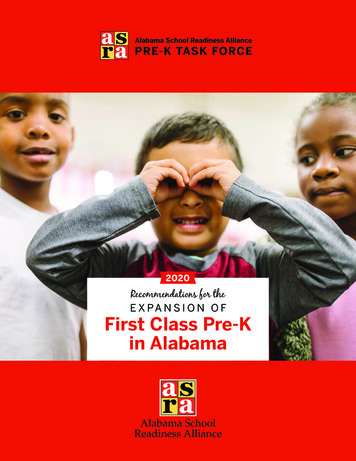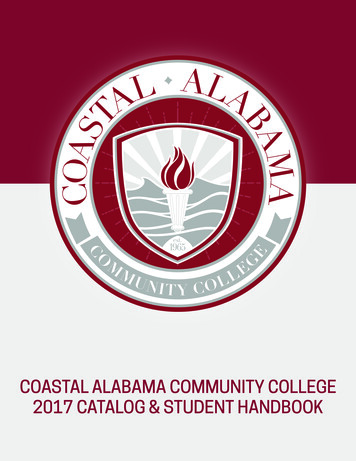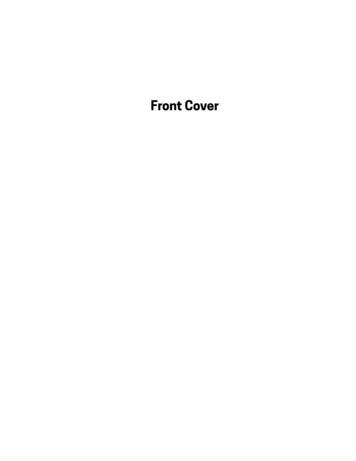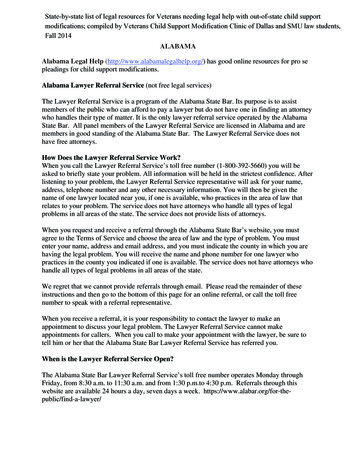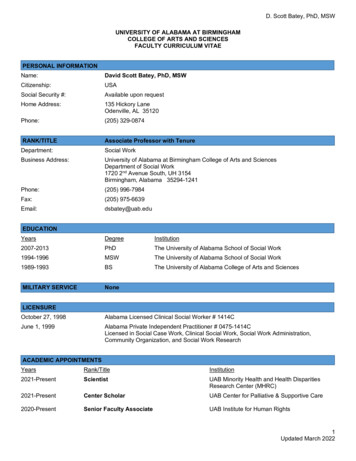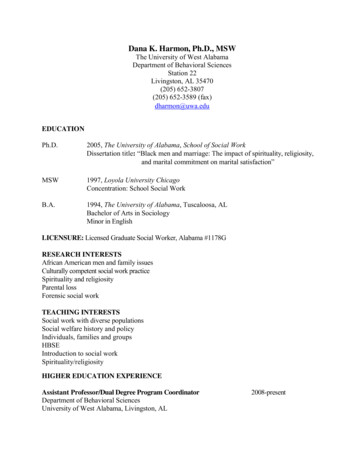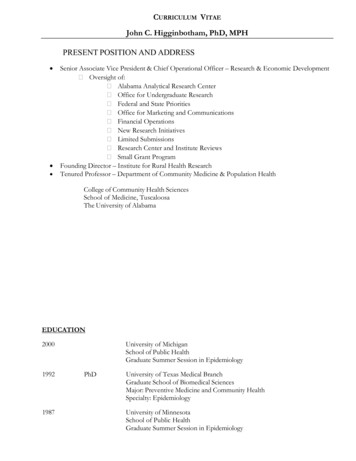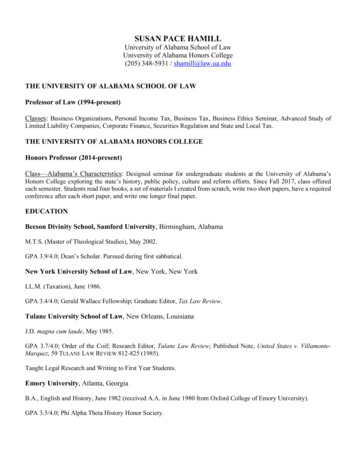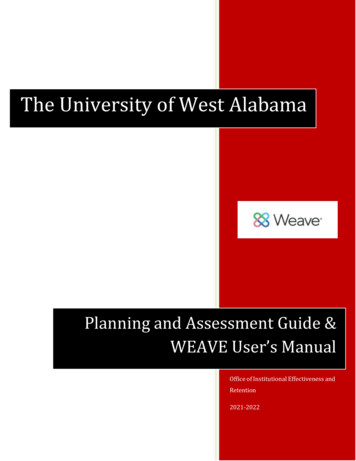
Transcription
The University of West AlabamaPlanning and Assessment Guide &WEAVE User’s ManualOffice of Institutional Effectiveness andRetention2021-2022
2WEAVE User Manual and Planning & Assessment GuideTable of ContentsTable of Contents . 2Introduction . 4Items Due in 2021-2022 Annual Plan Cycle . 5Resources . 5Timeline for Assessment Process . 5Thinking About Planning and Assessment . 6Planning and Assessment at UWA . 7Entering Goals and Outcomes (Annual Plans) . 8Assessment of Learning Outcome/Department Goals . 9Strategic Plans. 9Review and Approval of Annual Plans . 9From Thinking to Doing: Understanding and Using WEAVE . 11Entities and the Entity Tree. 11Login Information . 13Home Page Information . 13The Projects Tab. 14Institutional Mission . 15Departmental Mission . 16University Strategic Plan Goal. 17Student Learning Outcomes/ Departmental Goals . 18Measures . 19Targets for Measures . 20Project Attachments . 22Entering Findings and Recommendations & Creating Action Plans:. 22Resource Center . 25Appendix A . 27Student Learning Outcomes . 27Writing Student Learning Outcomes Worksheet . 30Writing Student Learning Outcomes Checklist . 31
3WEAVE User Manual and Planning & Assessment GuideAppendix B Approval Form . 32References . 34
4WEAVE User Manual and Planning & Assessment GuideIntroductionThis manual was created to help provide guidance and instruction for all WEAVE users at theUniversity of West Alabama in the planning processes for UWA. Because the processes are fluid anddynamic, this manual should be viewed as a work in progress that will expand over time and evolve as theUniversity does.WEAVE is a web-based assessment management application that helps manage accreditation,assessment, planning, and quality improvement processes for colleges and universities, detailinginstitutional effectiveness. It is designed to capture assessment information that ultimately supportsquality improvement in student learning and in the services provided by the University of West Alabama(UWA) in various forms. WEAVE focuses on continuous improvement in all academic programs,administrative and student affairs units, and other services, projects, and grants.Learning to use WEAVE requires not only understanding how to navigate the various parts ofthe application and enter data in the right boxes, but also how to decide what goes into those boxes. Thenavigation and data entry parts are relatively simple. The Help system built into WEAVE is accessiblefrom every screen and is a convenient way to access context‐sensitive help. The decision part is not assimple and should be well thought out before data is entered into WEAVE.
5WEAVE User Manual and Planning & Assessment GuideItems Due in 2021-2022 Annual Plan CycleThe following items are due on July 15, 2022 in order to have a complete Annual Plan submission:1. Assessment of 2021-2022 Student Learning Outcomes (Academic Programs only) and/or DepartmentalGoals2. Identified Action Plans for each outcome/goal demonstrating continuous improvement3. Updated status of previous Action Plan identified in 2020-2021All Annual Plans will be included in the UWA SACSCOC Reaffirmation Compliance Report. As such, plans whichare deemed incomplete will be returned and modifications requested. Please ensure that plans are complete uponsubmission date.ResourcesThe following resources are made available to help guide you through the process of completing an Annual Plan:1. Assessment Plan. The information provided below within this document outlines the process and goalof the assessment process.2. User Guide for Weave. Within this document, step by step screen shot instructions are provided inorder to guide you through the completion process3. Video Guides. Videos guides are available to accompany the screen shot instructions. You can findthose on the website resourcesandtraining. Please note that some terminology and labels might have changed for specific text boxes.Refer to the screen shot guide while watching the video. Edited videos are forthcoming4. Timeline for Assessment. A timeline is provided below in order to assist with understanding the fullcycle of this years assessment process.Timeline for Assessment ProcessJuly 15th, 2022August-September 2022October-November 2022Annual Plans are due and must becompleted in Weave. All plansshould be marked as “Complete”Annual Plans are reviewed byDean/Vice PresidentPlans are reviewed by OIE andmeta-assessment is completed5. Meta-Assessment Rubric. A blank meta-assessment rubric has been attached at the link below forreference on what criteria is expected in completing an annual plan. Please refer to this rubric tounderstand details on the narratives that are expected.
6WEAVE User Manual and Planning & Assessment GuideThinking About Planning and AssessmentThere is great benefit when a culture of assessment is embraced and nurtured on a universitycampus. In her book Assessment: Clear and Simple (2004), Barbara Walvoord states, “In the right hands,good information is potentially the best lever for change.” The planning and assessment process shouldprovide the information necessary to become the lever for change at the University of West Alabama.Walvoord goes on to write that if done properly, assessment “can provide a basis for wiser planning,budgeting, and change in the curriculum, staffing, programming, and student support, instead of wastingvaluable resources on vague notions about what might be effective.”There are three primary catalysts for the current “assessment movement,” which have arisen fromdifferent areas. One catalyst began outside institutions of higher education with legislators, employers,and other constituents who became disappointed and disillusioned with the quality of college graduatesand the ever rising cost of higher education. These constituents wanted institutions of higher education toprovide data-based evidence that they were providing quality academic programs and administrativeservices and not just claiming to do so. The second catalyst was educational reform movements. Reformmovements such as writing across the curriculum and learning communities needed data on learning inorder to build a case for meaningful reform. The third catalyst for the “assessment movement” wasincreased competition among institutions of higher education. Colleges and universities began using dataabout learning to market themselves and challenge other institutions. The greatest challenge that UWAand other institutions face is to identify what is productive about assessment and to use it to improve theinstitution (Walvoord, 2004).Planning and assessment is simply formulating a scheme to reach a specific goal and thenevaluating the attainment of that goal. It is the systematic gathering, analyzing, and interpreting of data toguide strategies and plan for improvement while measuring success. Assessment should not be thoughtof only in relation to outside accrediting bodies, but should be considered an integral part of theinstitution’s desire for continuous improvement in the academic programs and administrative servicesoffered to its various publics. Good planning and assessment are necessary steps for UWA to realize itsgoals, dreams, and initiatives. There are three steps to assessment: (1) articulate the goal, (2) gatherevidence about how well the goal is being met, and (3) use the information to make improvements.
7WEAVE User Manual and Planning & Assessment GuidePlanning and Assessment at UWAThe planning process at the University of West Alabama begins at the unit level, then moves tothe Dean/Vice President level at the Dean’s Council and then culminates at the President’s Council,where the direction and budget is set for the upcoming year. It is a continuous process designed toinvolve all areas of the institution and maintain comprehensive participation. Planning and assessment inWEAVE require units to work in a general-to-specific approach when planning objectives and assessingactual outcomes. Figure 1 is a visual representation of the process.Figure 1By the end of May, all units complete the planning portion of the process for the upcomingacademic year. This process includes developing, reviewing, and/or updating objectives that link tospecific University goals and determining expected results to form a comprehensive assessment plan. Thisplan is designed to guide academic units in assessing the quality of academic programs or theoperations/services of non-academic units. The planning process is done collectively, allowing all vestedindividuals a voice in the process.
8WEAVE User Manual and Planning & Assessment GuideBy the end of September, all units perform a self-study to analyze the results of assessmentactivities from the previous year. Using the self-study results, all units develop strategic action plans andnote any resources needed to accomplish set outcomes/objectives. This process allows each unit todetermine which parts of their current comprehensive assessment plan are working well and/or whichareas need improvement. When the self-study process is complete at the unit level, all planning andassessment documents are forwarded to the Dean/Vice President. Documents are then reviewed andapproved by the Dean/Vice President by the end of October.During the Spring Semester, the Dean’s Council and President’s Council are convened. Eachunit’s key accomplishments (noted on faculty and staff service reports) budget requests are reviewed bythe Dean’s Council members. The Council works to integrate the planning statements with budgetrequests and establish institutional priorities. The planning priorities established at the Dean’s Councilserve to guide final budget prioritization and budget recommendations to the President’s Council. ThePresident’s Council considers the recommendations of the Dean’s Council as a University Plan isdeveloped that determines the direction the University will take, which plans are to be supported andimplemented immediately, and available and needed resources. Final budget proposals are then presentedto the Board of Trustees for approval. At the conclusion of this cycle, the process begins anew, with unitsmaking needed changes in mission statements, objectives, assessment activities, and strategic plans basedon the assessment findings, unit/college/University strategic plans, etc.Entering Goals and Outcomes (Annual Plans)Goals and student learning outcomes are identified by each unit at UWA for the upcomingacademic year. The process is broken down into several different steps, beginning with the identificationof a broad, overall University-level goal and ending with targets. The task of identifying and enteringgoals and outcomes can begin anytime during the year, but must be completed by the end of July. Unitscomplete the following steps in succession to identify their goals/outcomes for the academic year justcompleted:1. Identifying University Strategic Plan Goal: Strategic Plan Goals are broad statements describingwhat a unit wants to accomplish. Goals must relate to both the unit's mission and the University'smission. For most units, the goal(s) will usually be stated as the University goal(s) a unit isattempting to meet.2. Identifying Student Learning Outcomes/Departmental Goals: Outcomes/goals arestatements that describe in some detail what a program/unit plans to accomplish.Outcomes/goals should be associated with all applicable goals, strategic plans, standards,and institutional priorities. See Appendix A for information on Student Learning Outcomes.3. Identifying Measures: M e a s u r e s a r e t h e m e a n s i n w h i c h a p r o g r a m o ru n i t a s s e s s t h e i r o u t c o m e o r g o a l . A measure should be accompanied by aprocess and data that can be used as "proof" that an outcome/objective has been met, such as asurvey, exam evaluation, committee minutes, etc.4. Identifying Targets: Targets are the thresholds that the measures must meet for a unit todetermine that it has been successful in meeting its specified outcomes/objectives. Targets aremeasurable statements. Targets are also referred to as benchmarks. Units are responsible fordetermining the target that is best suited for the measure and goal it sets out to achieve.
9WEAVE User Manual and Planning & Assessment GuideAssessment of Learning Outcome/Department GoalsThe assessment process in WEAVE is a self-study for units. As units identify the measures foreach outcome/objective, they can choose to select a source of evidence, such as a survey, project,presentation, etc., that will be used as documentation. The assessment of all student learning outcome andgoals should be complete by July 15th. Units perform self- studies to determine the accomplishments forthe previous academic year (Summer, Fall, and Spring) and to create action plans for reaching anymeasure that was not fully met and/or any budget requests deemed necessary. Assessment is an ongoingand fluid process and is conducted throughout the academic year by all units. Findings can be put intoWEAVE throughout the year; however, self-studies must be fully completed by July.The assessment process includes the following steps:1. Publishing Findings: Findings are indications whether an outcome/objective was met or not.Findings are put into Weave under each target. There is room for interpretation of results,possible uses of results, reflection on problems encountered, indicated improvements/changes,indicated strengths, etc.2. Completing Recommendations: The Recommendations are used for interpretation of results,possible uses of results, reflection on problems encountered, indicated improvements/changes,indicated strengths, etc. Each unit must enter a Recommendation for every Finding.3. Formulating an Action Plan: A detailed plan must be created by a unit to meet anoutcome/objective that was only partially met or not met. Action plans include information suchas how the plan will be implemented, a projected completion date, and all resources needed,including financial resources, in order for the plan to be successful.4. Reviewing Previous Action Plans: Units create detailed plans during each project for alloutcomes/objectives that were only partially met or not met. During the self-study, units shouldreview the action plans created in previous projects and note the progress on the action plan.Strategic PlansStrategic planning is very important to UWA. It not only occurs at the University level every fiveyears, but also in the unit level annually in short-range strategic plans. Drawing upon both the annual planand the self-study, units develop short-range strategic plans and describe the resources required forimplementation. Short-range strategic plans address any areas the self-study indicates are necessary, butmay take more than a year to accomplish. Each unit’s annual plan is linked to a University Strategic Plangoal in order to show congruency in annual planning.Review and Approval of Annual PlansAfter the planning and assessment process is complete on the unit level, all documents areforwarded to upper-level administration for review and approval. Documents for academic units areapproved by Deans and the Provost and documents for non-academic units are approved by the VicePresident responsible for that area. Key accomplishments from each unit (noted on the faculty and staffservice reports) and budget requests are presented at the Dean’s Council and President’s Council. Theapproval form can be located in Appendix G and an example of a formatted assessment document can belocated in Appendix H. The following steps outline the approval process:1. Approval forms and assessment reports are attached to an email with instructions on how to
10WEAVE User Manual and Planning & Assessment Guidecomplete the approval process. Documents and forms in Academic Affairs are sent by OIERto the Dean or Provost for approval. All non-academic unit documents and forms are sent tothe appropriate Director or Vice President.2. After reviewing the document for completion and proofing for errors, the approver willcomplete and sign the form.3. If changes are necessary, a copy of the form is sent to the appropriate person responsible formaking indicated changes.4. The original signed form is sent to OIE.5. After all necessary changes have been made to the documents, the Coordinator of Planningand Assessment approves the documents as final and sends copies to the appropriate Dean.6. Approved documents are placed on the OIER website.
11WEAVE User Manual and Planning & Assessment GuideFrom Thinking to Doing: Understanding and Using WEAVEAlthough there is context‐sensitive help within WEAVE, this manual supplements that content withinformation based on local users’ experiences and addresses issues unique to UWA’s process. Thefollowing chapter provides information that is helpful in understanding terms used in WEAVE as well asdetailed instructions for inputting information into each section of the WEAVE system.Entities and the Entity TreeWEAVE defines individual organizational units as entities. Individual entities are grouped togetherwithin the administrative area under which they fall in the UWA administrative organizational chart tocreate an entity tree. All entities participate in the planning and assessment process. For academic units,assessment is done at the program level. The offices of the President, Provost, and Vice Presidents do notcomplete planning and assessment documents as individual units, but participate in the process byreviewing and approving the documents for each entity in their particular area. The following is the entitytree in WEAVE: Campus Police DepartmentDepartment of AthleticsUniversity-wide ResearchDivision of Economic Development and OutreachVice President for Institutional Advancemento Alumni Relationso Fundraisingo Public RelationsVice President for Student Affairso Financial Aido Housingo Registrar’s OfficeoStudent LifeStudent Success Career Services Counseling/ADA Serviceso Undergraduate AdmissionsVice President of Academic Affairs (Provost)o Academic Affairs Office of Information Technology Office of InstitutionalEffectiveness and Retention Office of International Programs Quality Enhancement Plan (QEP)o College of Business and Technology Department of Accounting,Finance, and Economicso Accounting- B.B.A.Finance- B.B.A.Quantitative Finance &Econometrics- B.B.A.Department of BusinessAdministration, Management, andMarketing Department of Computer Information Systemsand Technology o Business Administration- B.B.A.Management- B.B.A.Marketing- B.B.A. Computer Information Systems- B.B.A.Engineering Technology- B.S./B.A.Automotive Engineering TechnologyA.A.S.Industrial Maintenance- A.A.S.College of Education Interdisciplinary Studies- B.S./B.A.Clinical Mental Health Counseling- M.S.Elementary Education- B.S./B.A.Elementary Education and Early ChildhoodUndergraduate/Alt-AElementary Education and Early ChildhoodEducation- MEDElementary Education and Early ChildhoodEducation- Ed.S.Early Childhood Development (non-cert)- B.S./B.A.Family Counseling- M.S.Counseling/Psychology- M.S.School Counseling- M.Ed.School Counseling- Ed.S.Guidance and Counseling- M.S.Counseling- Ed.S.Undergraduate Secondary Programs and Alt-AProgramStudent Affairs in Higher Education- M.Ed.Teacher Leader- Ed.S.Collaborative Teacher/Special Education (K-6)(612)- B.S./B.A.Special Education: Collaborative Teacher- M.Ed.Learning, Design, and Technology- M.Ed.Library Media- M.Ed.Library Media- Ed.S.Instructional Leadership- M.Ed.Instructional Leadership- Ed.S.Special Education- B.S./B.A.
WEAVE User Manual and Planning & Assessment Guide12 oCollaborative Special Education (K-6/6-12)- Ed.S.Rural Education- Ed.D.Campus SchoolCollege of Liberal Arts Department of Behavioral Sciences Public Safety- B.S./B.A.Psychology- B.S./B.A.Sociology- B.S./B.A.Sociology: Criminal Justice TrackB.S./B.A.Sociology: Community Health TrackB.S./B.A.Experimental Psychology- M.S.Department of Communications o Integrated Marketing CommunicationsB.S./B.A.Integrated MarketingCommunications: SportsCommunication TrackB.A./B.S.Integrated Marketing Communications:Graphic Design- B.A./B.S.Integrated Marketing CommunicationsM.S. Department of Fine Arts Department of History and Social Sciences Department of Languages and Literature Music- B.A.Interdisciplinary Arts- B.S./B.A. History- B.S./B.A.History Teacher Certification- B.S./B.A.History- M.A.T. English- B.S./B.A.English Language Arts TeacherCertification- B.S./B.A.English: Creative Writing Track- B.S./B.A.English: Publishing Track- B.S./B.A. Biology Comprehensive- B.S./B.A.Biology Teacher Certification- B.S./B.A.Cell/Molecular Biology- B.S./B.A.Conservation and Field Biology- B.S./B.A.Conservation and Field Biology- M.S.Marine Biology- B.S./B.A. Tutorial Mathematics- A.S.Mathematics Education- B.S./B.A.Mathematics Actuarial Science- B.S.Mathematics- B.S./B.A. Chemistry- B.S./B.A.Chemistry Comprehensive: ForensicTrack- B.S./B.A.Chemistry Comprehensive: PrePharmacy Track- B.S./B.A. Livingston PressCollege of Natural Sciences and Mathematics Department of Biological and EnvironmentalSciences Department of MathematicsDepartment of Physical Sciences oooooooooSchool of Health Sciences and HumanPerformance Health Sciences- B.S./B.A.Athletic Training-B.S./B.A.Exercise Science- B.S./B.A.Sport Management- B.S./B.A.Athletic Training- M.A.T.Physical Education- B.S./B.A.Physical Education- M.Ed./M.A.T.Physical Education- Alternate APhysical Education- M.S.Ira D. Pruitt Division of NursingJulia Tutwiler LibraryOffice of Sponsored Programs and ResearchSchool of Graduate StudiesVice President of Financial AffairsBusiness OfficePhysical PlantPrintingPurchasing and Inventory
13WEAVE User Manual and Planning & Assessment GuideLogin InformationWEAVE can be accessed from any computer with internet access. Unit directors determine thefaculty/staff in each area that will have access to WEAVE and what level of access is needed. Figure 1 isa screenshot of the login page for UWA.Instructions for Logging In1. Go to https://app.weaveeducation.com/login/. Create/edit a bookmark/favorite with this exactaddress before logging in.2. Enter a WEAVE ID and password, and click Log In. The WEAVE ID and password are thesame as each user’s UWA ID (not including @uwa) and password.Figure 1Home Page InformationThe Home Page (shown in Figure 2 below) is the first page users will view after logging into WEAVE.This page contains access to all Projects assigned to the user. You will see four tabs at the top center of thepage: Dashboard, Projects, Credentials, and Reports. The default tab is the Dashboard tab. For most users,the Projects tab will the tab used for most of the work being done within WEAVE. Click on the“Projects” tab. From this page, you can access Projects by searching the name of the project in the “Filterprojects” box, (OR) you can select the underlined Project name under “Title.” It is helpful to search forthe academic year in which you desire to enter results or update. For example, if you wish to access the2021-2022 plan, you can enter “2020-2021” into the search box or filter according to that year.
14WEAVE User Manual and Planning & Assessment GuideFigure 2The Projects TabThe Projects Tab in WEAVE provides access to all projects a user is assigned to currently. Click on thetitle of the project that you wish to edit.When a project is existing and information has been entered, the following page will appear by clickingon the underlined title:The user will be able to see all people assigned to this team as a user in the first column to the far leftunder “Team”. You will also be able to see if the user(s) have edit or read access. You can also assignusers to the project in this area.In the middle column, you can see two alternate views: Assessment and Outline View. In “Outline
15WEAVE User Manual and Planning & Assessment GuideView”, if no goals or measures has been entered, there will be no information listed in any category.However, if information has been entered, you will see an outline of the goals, outcomes/objectives, andmeasures in a sticky note view. From this sticky note view, quick edits can be made to any goal,outcome/objective, or measure by clicking on the wording. However, targets cannot be accessed fromthis view. In addition, new outcomes/objectives and measures can be added in the far right column. Tomake complete edits, you will need to click thesymbol in the middle column to access “Assessment”view. This will expand this column and allow access to make any changes needed to the existing goals,outcomes/objectives, measures, and targets. Once this column is expanded, you will see the followingcategories. Institutional MissionDepartmental MissionUniversity Strategic Plan Goals (with all Student Learning Outcomes/Department Goal, Measures, andTargets falling under this category)Project AttachmentsThe following is information on the sections found within the “Assessment” view and detailedinstructions for entering information into each section.Institutional MissionThe institutional mission statement is a declaration of the overall purpose of the University. Theinstitutional mission is established as part of the University Strategic Plan. This mission statement will begiven to each user to enter in this category, and it can also be found here within the 2020-2025 UniversityStrategic Plan: ions for Entering/Editing Institutional Mission1. After selecting a Project, and expanding the middle column by clicking thesymbol, the userwill see the “Institutional Mission” area (shown in Figure 4 below).2. To enter a new Institutional Mission, the user will click on “Enter Text,” and type the mission inthis box. When the entire mission statement is entered, click outside of the text box. By clickingoutside of the box, all information entered will be saved. There is no save button.
16WEAVE User Manual and Planning & Assessment Guide3. To make edits to the existing Institutional Mission, the user will click on the current institutionalmission, make the necessary changes, and again click outside of the box, which will save thenewly entered information.Figure 4Departmental
provide data-based evidence that they were providing quality academic programs and administrative services and not just claiming to do so. The second catalyst was educational reform movements. Reform movements such as writing across the curriculum and learning communities needed data on learning in order to build a case for meaningful reform.


